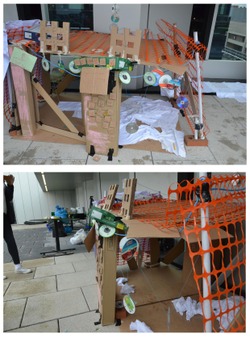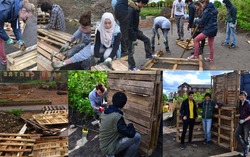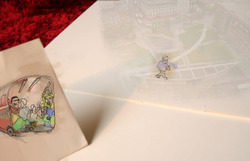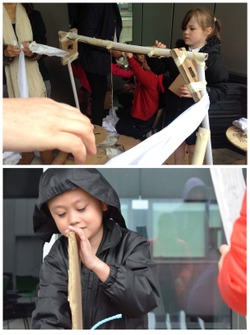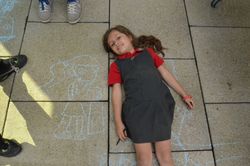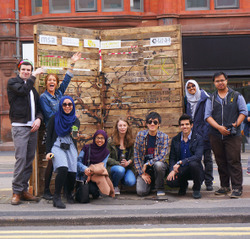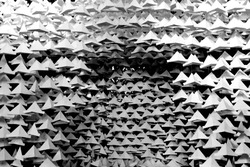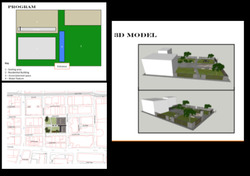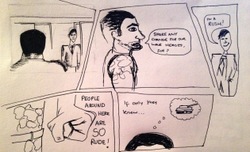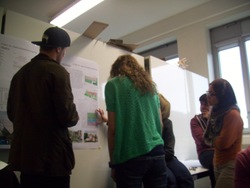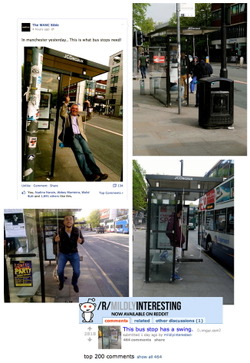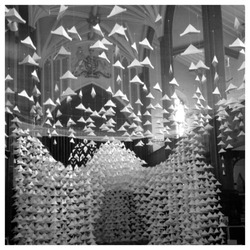Thursday 15th:
The installation is starting to take shape! Following the grid plan we had created was crucial in this stage, hanging each labelled thread in its correct position in order to create exactly what we had planned out.
Posted 17 May 2014 12:07
Enjoying their den after a hard day's work.
Posted 17 May 2014 12:04
A finished den.
Posted 17 May 2014 12:03
Day 05 & 06_session 006
: Completed off-site fabrication within two days. Mission accomplished!
Posted 17 May 2014 12:02
Wednesday 14th:
Deliveries at 9am: Timber, scaffolding, straps
After cutting the timber to size, we constructed the structure that sits in the galleries on either side, held in place by the pillars.
It took a day of testing and adjustment to span the net with the right tension over the required area using straps and rope.
Posted 17 May 2014 12:00
Day 04_session 005
: On the same day of presenting our final design to Helene from Hulme Garden, we have split up into three groups; as to refine, improve and finalize the construction, graphic illustration and planting to be used.
#a further advice concerning the construction issue from Scott Miller (a technician from SEED Architecture B/15 Workshop)
Posted 17 May 2014 12:00
HULME COMMUNITY GARDEN
: We had spent 4 days building our installation here. It is a great achievement by everyone as we managed to complete everything according to our plan. Good job guys!
Posted 17 May 2014 11:57
stopmotion in progress - animating the described journey of the construction worker through Picadilly from bus to construction site and the changes of space experienced in this journey.
Posted 17 May 2014 11:57
animating sketches with colour and including them in context for final slide of stop motion (finishing point of narrative)
Posted 17 May 2014 11:55
Hard at work.
Posted 17 May 2014 11:54
further design sketches for narrative to generate stopmotion
Posted 17 May 2014 11:54
Once the dens were built, they decorated them. It was interesting to watch how the decorations of each den brought out the personalities of the student that were involved.
Posted 17 May 2014 11:53
They experimented with different materials and built a sturdy structure for each den.
Posted 17 May 2014 11:52
We let them take a go at documenting the process.
Posted 17 May 2014 11:45
Testing and rigging the net on Tuesday 13th, before heading to Stocky P on Wednesday for the first installation day in St Marys church!
Posted 17 May 2014 11:44
Posing with her self portrait.
Posted 17 May 2014 11:42
FROM THIS ... TO THIS IN ONLY 2 WEEKS !
Posted 17 May 2014 11:34
Event 00
Posted 17 May 2014 10:50
Event 00
Posted 17 May 2014 10:50
Event 00
Posted 17 May 2014 10:49
Event 00
Posted 17 May 2014 10:49
Event 19 - Wearable Shelter
Posted 17 May 2014 10:49
Event 19 - Wearable Shelter
Posted 17 May 2014 10:48
Event 18 - Plug in Street Arts
Posted 17 May 2014 10:48
Event 8 - Mush Farm
Posted 17 May 2014 10:47
Event 8 - Mush Farm
Posted 17 May 2014 10:46
Event 18 - Plug in Street Arts
Posted 17 May 2014 10:45
Event 22 - MSA Pirates
Posted 17 May 2014 10:45
Event 00 - Camera Induction with Alan Sams
Posted 17 May 2014 10:44
Our finished micro structure!
Posted 17 May 2014 10:20
Had to work quick with Alginate as it would set within two minutes.
Posted 17 May 2014 09:12
Testing out a plaster cast in the Alginate cast, unfortunately the plaster test broke.
Posted 17 May 2014 09:10
After collecting all the work from everyone and combing it with mine I put together a powerpoint presentation, to which we made some adjustments as a group and then went on to presenting on the final day of the event.
Posted 17 May 2014 08:27
On the last day of preparation, the team finalised the installation with a number of separate strings hanging from all over the net. 'The clouds became the sky'. On 17th May we are required to take the installation off after the shows took place, and of course we will be there to enjoy the shows ourselves.
Posted 17 May 2014 08:19
Finalised visual proposal for the car park in China town.
Posted 17 May 2014 08:12
The next day, everyone had to participate in the assemblage of the installation, a.k.a. putting the hats on. Once again, team work was essential, and the group did very well on this day as well. The main bit of the installation, the backdrop itself was fully built. Discussion took place regarding the 'clouds' which were meant to be separate, smaller bits of hats hanging from above the audience. The need of this became debatable, since the backdrop stood out very well itself.
Posted 17 May 2014 08:08
A few days after we met as a group we had a brief tutorial meeting with the tutors about our proposal for China town. We shared our ideas with them and got some constructive feedback, and then we went on doing our share of the work.
Posted 17 May 2014 08:04
Following on from the preparation process in studio, half of the team went to the church site, in order to start putting up the fishing net that will hold all the strings of paper hats in place. Great team work and good vibes resulted in both the net and the scaffolding up in place by the end of the day.
Posted 17 May 2014 07:58
As a group we identified the problem that the centre of China town was being wasted as a car park and thought we could turn it into something more productive. Since the centre lacks green spaces we propose to transform the car park into a park, offering the Chinese society living there a recreational and communal area.
Posted 17 May 2014 07:46
On the first day of the event we had a lecture by Dr. Haley after which we overviewed a few of his Chinese student's presentations on future living in China. Afterwards we were split into groups and went on to doing some field research. After identifying a few problems, we had to think of a proposition for future China town.
Posted 17 May 2014 07:32
The concept of new urbanism and how it applies to China.
Posted 17 May 2014 07:00
Beginning to edit my film using Movie Maker. Filtering through and collating all of my footage to express and translate my theme.
Posted 17 May 2014 05:26
Development of my Comic Strip, based around real individuals at Shudehill Interchange and how they interacted.
Posted 17 May 2014 05:23
My comic character, 'Ste', based upon interviews and interactions with real people at Shudehill Interchange.
Posted 17 May 2014 04:54
We Interviewed people in and around Shudehill interchange to build an understanding of the site through those using it. Questions I posed included 'Why are you here?' and 'Do you think this is a place where people interact?'. Responses were overwhelmingly negative; Members of the public viewed each other as 'peculiar' and 'rude'.
Posted 17 May 2014 04:53
I never expected alginate, a dental material, to be so practical in architecture as well. It seemed to be a perfect material for the moulds since it sets in a couple of minutes and is flexible. We also used it for applying textures to the components.
Posted 17 May 2014 04:49
Recording footage in and around Piccadilly Gardens to create short films that reflect a chosen theme; mine was occupation. What makes people occupy this space and how do they go about it?
Posted 17 May 2014 04:46
Although we built a cardboard structure to support the components, the casting didn't turn out how we expected it to. Therefore, we exhibited our research and material experimentation.
Posted 17 May 2014 04:36
Collaboration with Manchester Urban Sketching Group; Manchester Library.
Posted 17 May 2014 04:24
We mixed concrete in different ratios of cement, sand and water to find the best colour and consistence.
Posted 17 May 2014 04:21
We presented our project and got feedback from Edward Fox and Dr. David Haley.
Posted 17 May 2014 02:51
Final day exhibition demonstrating some of the principles of the 'blue economy'. We had utilized waste products like used pallets from construction sites, recycled containers from home, and used coffee grounds from the local cafe, to design and build an urban mushroom farm.
Posted 17 May 2014 02:38
I was assigned the task of making the technical drawings for the project. I started by drawing the context and then our vision in plan and section on AUTOCAD. Then I further edited them in photoshop.
Posted 17 May 2014 02:34
The fully operational mushroom farm on a sunny day.
Posted 17 May 2014 02:26
My personal re-visit to the site helped me further appreciate the site when it comes to scale and further site analysis
Posted 17 May 2014 02:26
My Group chose the car park as our primary site. We felt it was not used to its maximum potential as a car park and quite frankly wasn't needed at all. We decided to turn its function to that of a park that serves the surrounding businesses, kind of like a centre within the centre of manchester.
We also looked precedents to aid our design process.
Posted 17 May 2014 02:15
The vessels accommodating the growing mushrooms are secured to the built intervention with thread.
Posted 17 May 2014 02:14
Presentation stand construction completed. It has been designed and built to house a laptop, which will screen the video of the entire project, and to frame the mushroom farm intervention from a defined angle.
Posted 17 May 2014 02:10
A rooftop polytunnel for growing leaf crops and a forest garden using the techniques of a woodland ecosystem are some of the ways the Biospheric Foundation are able to replicate the conditions of distant ecosystems in an urban environment.
Posted 17 May 2014 02:02
Site Visit: China Town, Manchester.
After getting spilt into four groups, we ventured out into chinatown to observe the area. Restaurants, Massage parlours, nail and hair salons and night clubs were the most prominent features of the area.
Posted 17 May 2014 01:39
2 of the food production systems at the Biospheric Foundation. A vertical leaf crop farming system and indoor mushroom growing.
Posted 17 May 2014 01:38
Planting mushroom spawn by mixing it in with the used coffee grounds in a re-used plastic jar.
Posted 17 May 2014 01:34
Review of A1 presentation boards showing final ideas and designs for the baths.
Posted 17 May 2014 01:25
Testing the loads it can bear, and see how people react to this moving bench.
Posted 17 May 2014 01:22
First floor plan
Posted 17 May 2014 01:19

An Essay on Chinese Cities
When we look at China, it is impossible not to notice the urbanization of the nations cities. “Just over 680 million now live in cities – 51.27 per cent of China's entire population of nearly 1.35 billion.” (Telegraph, 2012)
The majority of this move has happened in the past two decades as a result of the response to the boom in economic opportunities. People seeking for better job opportunities and higher pay; the migration from fields and modest homes to office and high rise apartment blocks. This is similar to that of Manchester, in the 1800s. A period marked for the rise of the Industrial Revolution. Large numbers of people migrated to Manchester for the hope of better life, better jobs, but the reality of the situation was different: bad and expensive accommodation, houses with no heating, poor hygienic environment; all in all very poor standards of living. China on the other hand is dealing with the problems that urbanization causes. There have been a massive drive to provide good housing, health and education facilities in the cities. However, the rapid modernization and demand for improved living standards is pilling extra pressure on the society and the already blighted environment. Many of those settling down in urban areas are migrant workers – people moving from the country to cities to seek economic empowerment.
This transient population of cheap labour, put at nearly 221 million by a national census last April, helped turn China into the world's second-largest economy in just three decades. (Telegraph, 2012)
The influx is seen as having a destabilizing effect on urban society, according to experts. Unfortunately, government policy has not been updated, so migrant workers are still classed as rural residents. The outdated Hukou housing registration system ties migrants to their hometown and this means they only have access to benefits back in their local towns. This brings about very little to no social security and results in most migrant workers being treated as lower-class citizens.
Along with urbanization comes the process of gentrification.
Gentrification is a shift in an urban community toward wealthier residents and/or businesses and increasing property values. Gentrification typically occurs when the government open up the ties with private companies to help spur economic development and attract business all with the aim of tackling urbanization.
The negative effect of this is that a lot of migrant workers are forced to stay in the cities even with very poor wages and standard of living because their farms have been taken from them by land grab schemes. These large corporations are merciless in the execution of their schemes, they capture land owned by the farmers and build insensitive structures therefore displacing the original tenants.
Another effect of urbanization is climate change. Industries are using more energy and in turn burning fossil fuels. It is estimated that in 50 to 100 years, coastal cities will be affected greatly but rise in sea leves including china’s richest province- Guandong.
It seems unrealistic that technology will be able to cope with the sheer danger of climate change. It is anticipated that when south east Asia is affected by changes in sea level for instance, the rich will migrate leaving the poor to face the problems. Its amazing that the capitalist society we live in, the rich create the problem and leave the poor overwhelmed in attempts to solving them.
Images added as part of the essay to illustrate ideas.
Images gotten from :
http://www.scmp.com/sites/default/files/styles/980w/public/2013/11/11/planting.jpg?itok=zRvSJOjm
Posted 17 May 2014 01:16
THE AFTERMATH
Public recognition.
Posted 17 May 2014 01:13
DAY 6
Installing our final piece. A BUS STOP SWING!
Posted 17 May 2014 01:12
Details.
Posted 17 May 2014 01:11
DAY 5- Afternoon
Burning our wood swings again to get a more curved effect, followed by scrubbing them with wire brushes, finishing with spray painting one blue!
Posted 17 May 2014 01:10
DAY 5- Morning
Blowtorching our swings in the workshop.
Posted 17 May 2014 01:09
Fabrication: Liquid making.
Posted 17 May 2014 01:08
DAY 4- Afternoon
Our final gorilla model scene.
Posted 17 May 2014 01:07
Fabrication: Cylinders filled with sands. Ready to be insert ed into the ropes.
Posted 17 May 2014 00:58
Session 4
Analysing the site (Northern Quarter) and sketching our initial ideas.
Posted 17 May 2014 00:58
Last Day_
We gave a presentation on our proposal to Sale west to the residents and it is nice to hear what people who use the space think about our idea, to create a sport centre with basketball court, tennis court, skating court and running running. And this drew to a delighted end for the event.
Posted 17 May 2014 00:56
Session 3_Mark-making
Posted 17 May 2014 00:49
From 'clouds' to 'sky'. The concrete design plan abandoned for a more spontaneous formation. Initial concern that these threads would detract from the main screen, however, there's a loose symmetry to the new additions- transforming the installation from a flat screen to a sculptural piece running through the space.
Posted 17 May 2014 00:43


